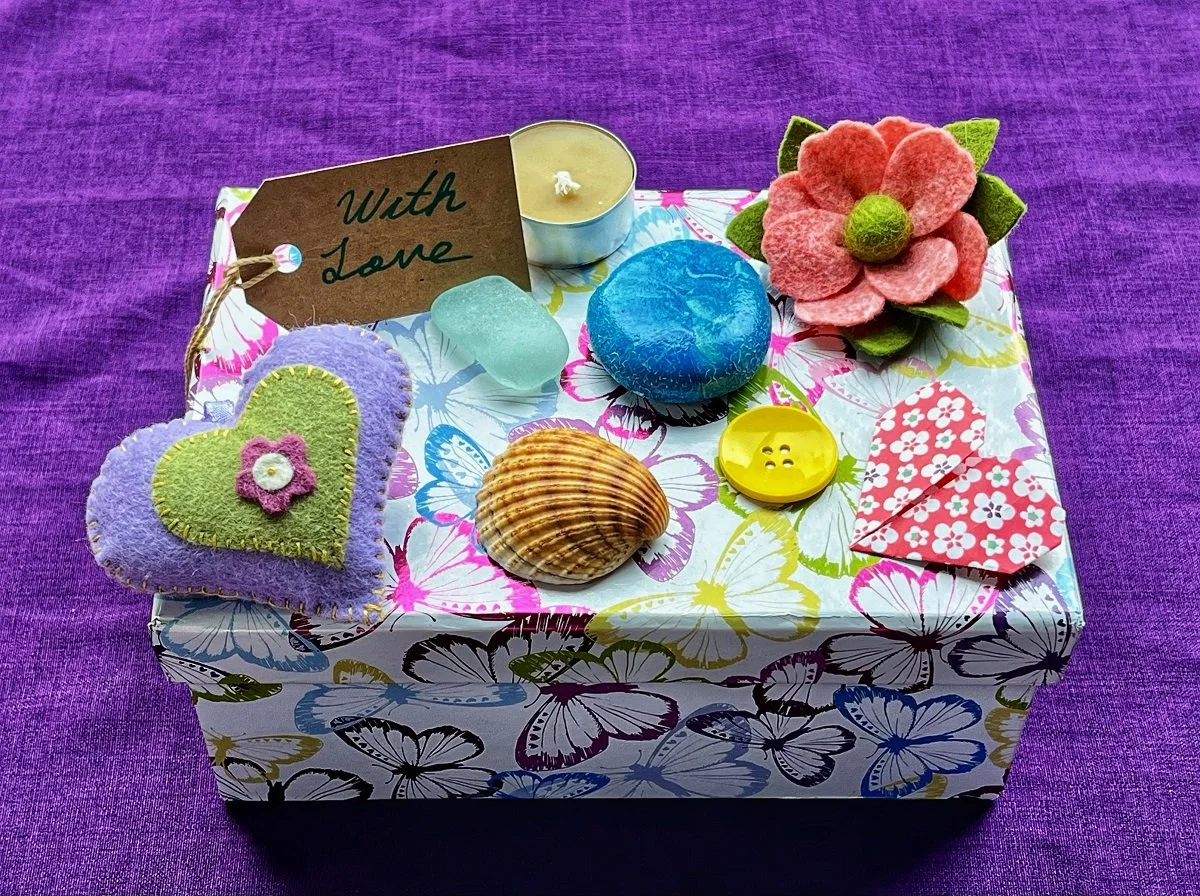How to make a bereavement memory box
What is a memory box?
A memory box serves as a dedicated container for storing treasured objects that hold special significance in your life. These can encompass memories relating to places you’ve visited, meaningful relationships, personal achievements, and more.
Creating a memory box and periodically revisiting its contents can prove to be a valuable method for recalling and reconnecting with joyful and memorable moments. The act of looking through a memory box has the potential to enhance your sense of gratitude, celebrate a reminder of personal accomplishments,
Looking through a memory box may increase your sense of gratitude, recognise your achievements and uplift your mood.
The concept of memory boxes is not novel, having been employed for centuries to preserve beloved items and commemorate those who’ve passed away.
What is a bereavement memory box?
This is similar to a general memory box but its primary focus is to commemorate the cherished moments of a departed loved one. A bereavement memory box can be filled with mementoes, photos, and other significant items that serve as reminders of the person who is no longer with us. Many individuals have found bereavement memory boxes to be a useful tool in navigating the complex emotions of grief.
Benefits of a bereavement memory box
Creating and revisiting a bereavement memory box often serves as:
A tangible means of preserving precious memories of a departed loved one;
A way to feel closer to the person who’s passed away;
A method of honouring the deceased and celebrating their life;
A tool to aid in processing grief and the accompanying painful emotions;
A prompt for sharing memories with others;
A source of comfort.
It’s worth noting that the process of creating and exploring a memory box may evoke intense emotions. Should this be the case, seeking support from a friend, a family member, or a bereavement counsellor, may prove helpful and comforting.
Ideas for creating a memory box
When it comes to crafting a memory box there are no strict rules. However, in the following sections, I aim to inspire and guide you as you embark on this meaningful endeavour:
Consider using a box or container that already holds significance to you, or select one that resonates with the theme of the memories you wish to preserve.
If you don’t have a specific box, there are various options to explore such as gift boxes, storage boxes, craft your own, or specially made containers.
Personalising your memory box
Opt for any shape or size of container that feels right for you;
Personalise the box using stickers, paint, ribbons, or any other items that hold significance to you;
Consider adding a personal touch by writing the person’s name on the box or affixing a photograph.
What to include in a bereavement memory box
Your memory box can hold a diverse array of items that hold significance to the memories shared with your loved one. Here are some ideas for things you might want to consider including:
Photographs, clothing, and jewellery of the person you’ve lost;
Letters, postcards, or printouts of emails;
Music associated with this person - CDs, memory sticks, or album covers;
Tickets from holidays, theatre trips, or concerts;
Tourist leaflets from places you’ve visited together;
Sporting certificates of medals from events;
Objects from special occasions such as weddings, civil partnerships, graduations, or parties;
Memorial items such as funeral service programs, sympathy cards or pressed flowers.
Remember, the possibilities are endless, the key is to include items that hold personal meaning to you and invoke connection and memories of the person you’ve lost.
Managing your memory box
There’s no rush to fill the memory box. Take your time. You might want to add things gradually or swap items as needed.
You can use a single memory box to hold a variety of items or opt for multiple boxes to categorise different types of memories or time periods.
In this process, your unique preferences and memories guide the creation of a cherished space. A space that honours and preserves special moments shared with your deceased loved one.
Revisiting your memory box
Memory boxes serve as a heartfelt way to honour cherished memories of a departed loved one and aid in the processing of grief.
Once you’ve created your box, the next step involves deciding where to keep it. Consider the following ideas:
Prominent display - Showcase it somewhere prominent such as on a bookcase or a coffee table;
Centrepiece for gatherings - As a centrepiece during gatherings with others who share memories of the deceased. It may encourage mutual support, discussion and the sharing of stories about the person who’s died;
A private yet accessible - Place it somewhere private but you can still see it, like your bedside table.
Selective viewing - Keep it in a cupboard, allowing you the choice of when to revisit it.
Allocate time to go through the contents of your box. Initially, this may be challenging as it engages you with your grief. Over time you may find you can gain comfort in reviewing your box and the connection and memories it invokes. However, if reviewing your memory box feels too overwhelming don’t push yourself. If going through the box feels too overwhelming you might want to consider:
Gradual engagement - Spend time only looking at the outside of the box or holding it;
Step-by-step approach - Focus on one item in the box then put it away. The next time you revisit the box try focusing on a different object.
Time limit - Set a reasonable time limit for how long you can engage with the memory box before it becomes overwhelming.
Self care -Engage in something distracting or calming afterwards like attempting to solve a puzzle, going for a walk, or engaging in a creative activity;
Seek support - Reach out to a friend, a family member, or a grief counsellor for support.
Memory boxes for baby loss
If you’ve experienced the heartwrenching loss of a baby, your memory box may include specific items such as a lock of hair, scan pictures, or a teddy bear. To learn more about creating a memory box for baby loss, consider visiting resources such as:
Tommys webpage on ‘Remembering your baby after stillbirth.’
Oscars Wish Foundation on creating a memory box with bereaved siblings. Although it’s aimed at siblings it contains ideas that may prove beneficial to bereaved parents too.
Bereavement Memory Box summary
A bereavement memory box serves as a personalised container for treasured items of profound significance for those grieving the loss of a loved one. These items may range from, photos and letters, to meaningful items of clothing and jewellery. The creation of a memory box has no fixed rules. The design of the box and its contents are unique to each individual.
Memory boxes can be a tangible representation of a person’s life, offering a means to remember and honour their memory.
Creating and reviewing a memory box can be a therapeutic activity, aiding in trying to process the loss of a loved one and the challenging feelings associated with it. Many individuals find these boxes provide comfort and a sense of closeness to the deceased.
However, if the process becomes too overwhelming I encourage you to seek support. Friends, family members or a bereavement counsellor may be able to assist you in navigating this emotional journey.
Bereavement Counselling
If you’re facing difficulties in coping with grief, bereavement counselling may be a valuable resource. I am an experienced and qualified counsellor with specialist training in bereavement and grief.
I offer face-to-face, phone and online appointments from central Durham.
If you’re interested in learning more about bereavement counselling, please contact me or visit my grief therapy FAQ page.



